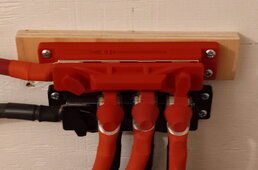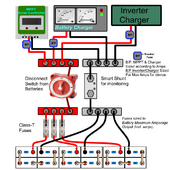When installing battery packs in Parallel to a common DC Bus we highly recommend using the exact same length of wires (+) & (-) from Packs to Busbar. If installing a Fuse/breaker between battery pack & busbar, that is extra in-between. Fuses/Breakers are always on the (+) and Shunts are always on the (-).
Each 200AH Battery should be fused according to max output potential. So if the BMS can handle 200A "Continuous" then 200 X 1.25 = 250A Fuse/Breaker should be used. With 24V You can use either MEGA, Class-T or MRBF Fuses without issue. I am 24V and religiously use MRBF because they are a great match. DO NOT SKIMP HERE ! Quality Fuses/Breakers can & will save your gear & life ! Crap knock offs can harm & injure !
Easily and economically satisfies ABYC 7 circuit protection rule by mounting on a 3/8 battery post, battery switch or bus bar.

www.bluesea.com
SPECIAL NOTE !!!
There are MANY busbars out there and an awful lot of them are JUNK ! Either too thin copper or poorly made or using non-thermal plastics... Boy we have seen the gamut of crap being flogged. Those cheap "pairs" for < $50 USD are the worst offenders that people buy cause it "looks" like a good deal. I Very Highly recommend quality busbars like PIKE Industries or Victron/BlueSea because you really do get what you pay for. I personally use PIKE Industries ones.
https://pikeind.com/industries-busbars/
View attachment 219339
Pike Industries busbars.
Top one offset with 3/4" so that the MRBF's clear over the accompanying (-) wire
(+) & (-) wires from Batt to Busbars are kept tight together to prevent EM/RF noise.
An A-Typical Component system with a parallel battery bank
View attachment 219340




